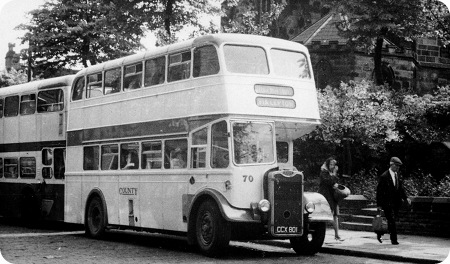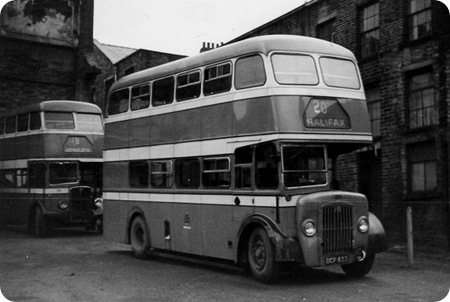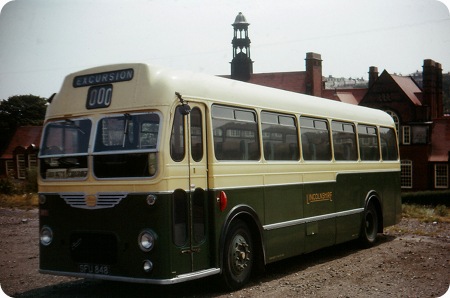
Photo by ‘unknown’ if you took this photo please go to the copyright page.
County Motors
1945
Guy Arab II
Roe L27/26R
This photo was taken at the Huddersfield terminus and the bus behind is a Guy Wulfrunian probable owned by West Riding. The Wulfrunian was said to be very advanced for the time, but I have read somewhere that the only advanced thing about it was the all round air suspension, lets face it the rather strange layout of the engine and stairs didn’t exactly catch on did it, if you disagree leave a comment.
But back to the County Motors Arab II this bus apparently has been preserved but at the moment I have not been able to come up with a link to a dedicated website, if you know, let me know.
It started life with a wartime utility body but was re-bodied in 1953 by C. H. Roe Leeds and ended up two seats less at the end of it.
Hard to tell which engine this bus had as all Arab IIs had the extended radiator to accept either the six cylinder Gardner (6LW) engine of 8.4 litre or the shorter five cylinder 7.0 litre Gardner (5LW) engine. Although knowing Huddersfield as I do then I think this bus would of handled the surrounding hills much better with the larger 6LW engine, either that or the driver would have to be very good at changing gear, especially down.
“Anything—pictures or info—on Guy Arabs is fascinating. Greatly enjoyed pictures and comments.
In Reading we had utility Arab 5LWs and 6LWs until 1949-50, when they were sold on. No 27 seemed to be everyone’s favourite. How I wish one had been preserved…!”
Ian Thompson
“I can confirm that County 70 has a 6LW engine. At the time of re-bodying in 1953 it was fitted with a transmission of contemporary (i.e. Arab IV) design, which makes it much easier to drive than the original twin-plate clutch and sliding-mesh gearbox of the Arab II. This bus is currently in the Dewsbury Bus Museum.”
Peter Williamson
10/02/21 – 07:13
County 70 is preserved and is now semi-restored at the Dewsbury Bus Museum awaiting a full repaint.
Can confirm it is a West Riding Guy Wulfrunian behind. The other advanced engineering on it was that Wulfrunians had disc brakes.
Graham Crawshaw
11/02/21 – 07:17
Graham’s post has drawn my attention to my earlier statement about 70’s transmission. Since writing that, I have discovered that the last Arab IIs to be built had the constant mesh gearbox from new, and so it may be that 70’s transmission is original. Sorry about that.
Peter Williamson
12/02/21 – 06:10
The transmission of the wartime Guy Arab consisted of a twin plate clutch and a four speed sliding mesh (crash) gearbox that dated from the 1920s, in which the gear selector operated from right to left for upward changes. During the summer of 1945 Guy began fitting the Arab with a single plate clutch coupled with its new all constant mesh gearbox, in which, unusually for the time, even first gear had constant mesh engagement. This gearbox, which selected gears in the by then conventional left to right sequence, was designed and developed during the conflict, but pressures of wartime delayed its appearance in service. This transmission proved to be immensely robust and reliable and remained an option right to the end of Arab production.
Roger Cox
12/02/21 – 12:12
I was for a time part-owner of Provincial 55 which has the reverse gearbox. The gear lever was fitted with a red knob rather than a black one to indicate this; I am not sure whether this was an original Guy feature, or fitted by Provincial, but I believe the former. I don’t recall the box as being tricky to master, other that having to remember where to put the stick!
Alan Murray-Rust
13/02/21 – 07:07
My Arab which also has a reverse gearbox has a black knob. Issue with the gearbox is that unlike Leylands or Bristols you have to place the gear lever the others allowing you to use the selector box sides for guidance.
Roger Burdett
13/02/21 – 07:08
The red gear lever knob was originally fitted to the later constant mesh box to indicate the correct left to right sequence. The old Guy gearbox had a black knob. No doubt things got swapped about in the course of time.
Roger Cox
13/02/21 – 07:09
I’ve not met any Guys with the reverse gearbox, but those with the constant-mesh box usually had maroon gear lever knobs. Even the Daimler CCG models, which had the same Guy gearbox, had maroon knobs.
Peter Williamson
14/02/21 – 07:00
London Transport lopped a couple of inches off their reverse gearbox Arabs., compared with the later ones.
Chris Hebbron



